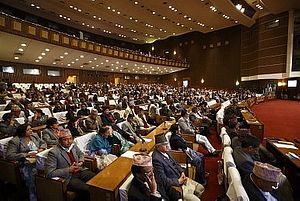Nepal’s constitutional deadlock is deepening ahead of the Constituent Assembly’s (CA) self-imposed January 22 deadline. As a month of street protests and strike action continues, ideological and procedural barriers hamper the promulgation of a new document.
Key issues unresolved by the last CA, which was dissolved in May 2012 after failing to reach an agreement, continue to impede progress this time around. After Nepal’s decade-long civil war ended in 2006 and the country moved from monarchy to republic, Nepal has been governed by an interim constitution.
On January 5, the 30-party opposition alliance, which comprises 19 parties holding seats in the CA and 11 parties outside of it, made clear its position on contentious issues including the parliamentary model adopted, Nepal’s revised federal structure, the country’s judicial setup, and the electoral systems by which it will appoint members to its bicameral legislature.
The Unified Communist Party of Nepal (Maoist)-led alliance favors an identity-based, 10-province federal model, a separate constitutional court as the final authority on constitutional matters, and a mixed member proportional electoral system. Though it advocates a directly elected president and a parliament-elected prime minister, the executive powers each would be accorded is yet to be decided.
The Nepali Congress and Communist Party of Nepal (Unified Marxist Leninist) ruling coalition stands by a 7 province federal set up, the retention of the Supreme Court as the final authority on constitutional disputes, and a proportionally elected National Assembly (upper house) coupled with a 65:35 split of first-past-the-post and proportional electoral systems in the House of Representatives (lower house). It is in favor of a parliament-elected prime minister with executive powers, and a largely ceremonial president.
Speaker Subash Nembang, who has been criticized for his failure to lead the previous CA to an agreement, has been scathing in his assessment of the performance of political leaders ahead of the January 22 deadline, claiming that consensus could be achieved within two hours if political forces were willing to compromise.
Though the ruling coalition has long played-up the possibility of putting contentious issues to a vote in the CA, the possibility of doing so requires the approval of the Political Dialogue and Consensus Committee, which to date has been unable to forge consensus on disputed issues and is unlikely to allow the matters to be put to a vote in the lawmaking body.
Though Nembang’s earlier deadline for consensus lapsed, parties remain committed to resolving the issues themselves rather than allowing Nembang to draft a document in order to circumvent the current procedural deadlock. If contentious issues are decided via a vote in the CA, the ruling coalition’s strong showing will allow it significant leverage.
As the January 22 deadline draws near, extra-parliamentary pressure is being marshaled by parties fearful of a constitution derived via a two-thirds majority. Nationwide protests organized by the 30-party opposition alliance demanding the promulgation of a new constitution via consensus began on January 3, and are planned to continue throughout the month.
The hardline Mohan Baidya-led Communist Party of Nepal-Maoist, which boycotted CA elections in 2013, has likewise announced its own protest program calling for the formation of an all-party assembly to resolve contentious issues, while the Adibasi Janajati Rastriya Andolan last week held rallies to press leaders for an identity-based federal structure.
The patience of Nepali voters is similarly wearing thin. On December 23, a protest led by the Professional Alliance for Peace and Democracy in coordination with the Nepal Federation of Journalists was organized outside the CA, urging political leaders to reach consensus and promulgate a constitution as per the timeline laid out in the wake of 2013 elections.
As negotiations between the four main political forces drag on, political and civil unrest will become increasingly pronounced.
Michael Vurens van Es (@mickvve) is a Kathmandu-based journalist.
































